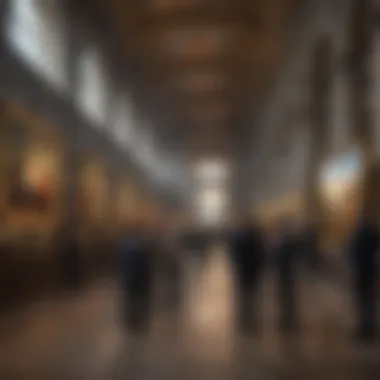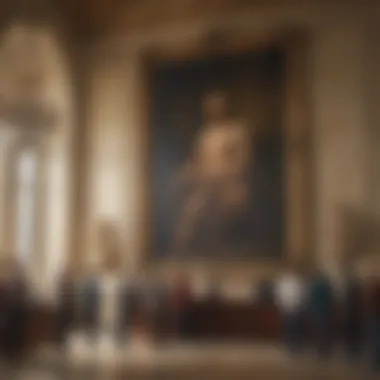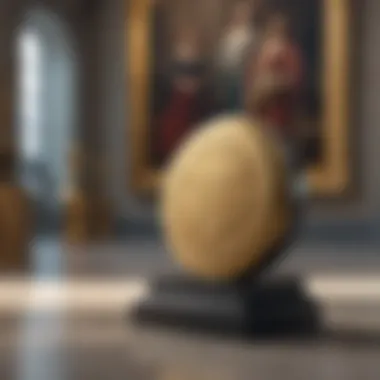An In-Depth Look at Louvre Museum Exhibitions


Intro
The Louvre Museum, located in Paris, is a revered institution known for its extensive collections and historical significance. Within this cultural landmark, louvre exhibitions play a crucial role in shaping public understanding of art and history. These exhibitions are more than mere displays; they are carefully curated events that engage visitors in a profound dialogue with artistic works and their contexts.
In this article, we explore the multifaceted concepts surrounding louvre exhibitions, including their origins, purposes, and their impact on visitors. This comprehensive analysis lays a foundation for understanding how the Louvre continues to influence the art world and adapt to contemporary challenges.
Foreword to the Louvre
The Louvre Museum in Paris represents a convergence of art, history, and culture. As one of the largest and most visited museums in the world, its exhibitions offer a glimpse into not just the artistic treasures it houses, but also the ways those artworks are contextualized and presented to the public. Understanding the Louvre is essential to grasping the evolution of art exhibition practices from the past to the present.
Historical Significance
The Louvre's history is profoundly intertwined with the cultural developments of France. Originally a fortress built in the late 12th century, it transformed over centuries into a royal palace before finally being opened as a public museum in 1793 during the French Revolution. This transition marks a pivotal moment in the democratization of art, where artworks became accessible to the masses rather than being confined to the elite.
The significance of the Louvre extends beyond its historical timeline; it reflects societal changes and the nature of art appreciation. This transition helped establish museums as critical institutions in fostering cultural understanding and preservation.
Architectural Evolution
The architectural transformation of the Louvre is as noteworthy as its historical context. The museum’s original medieval structure gives way to later additions, notably the Renaissance-style expansion by Louis XIV and the iconic glass pyramid designed by I.M. Pei, completed in 1989. This blending of styles speaks to the layers of history encapsulated within its walls.
Individual wings, such as the Denon, Richelieu, and Sully, exhibit distinct architectural traits and meticulously house collections from different periods. Each section of the museum not only serves a functional purpose but also contributes to an artistic narrative that echoes throughout the visitor's experience.
The physical space of the Louvre also informs how exhibitions are crafted and curated. The interplay between light, space, and viewer engagement is a critical factor, influencing both the presentation of works and the reception by audiences. Thus, the structure itself informs the dialogue between art and spectator, creating a dynamic and ever-evolving exhibition environment.
Defining Exhibitions
Understanding the concept of exhibitions is essential in the context of the Louvre Museum. This section aims to clarify the significance and multifaceted nature of exhibitions, which are not merely displays of art or artifacts but are also powerful narratives that engage viewers. By exploring the purpose and role of exhibitions, as well as their types, we can see how they contribute to the museum's mission of education and cultural enrichment.
Purpose and Role
Exhibitions at the Louvre serve several key purposes. Primarily, they function to showcase art and artifacts that might not normally be on view, thus allowing for broader access to cultural heritage. They also serve educational functions, providing context and interpretation of art pieces that can deepen visitor engagement. Each exhibition is an opportunity to explore themes, ideas, and historical periods that resonate with a wide audience. The role exhibitions play is fundamental to fostering a deeper appreciation of art and its impact on society.
Types of Exhibitions
Exhibitions can generally be categorized into two main types—temporary exhibitions and ongoing exhibitions. Each type has unique characteristics and serves different purposes within the museum's broader strategy.
Temporary Exhibitions
Temporary exhibitions are often highly anticipated events at the Louvre. They typically run for a limited time and are organized around specific themes, artists, or historical periods. This type of exhibition allows the museum to attract repeat visitors and engage new audiences with fresh content. The key characteristic of temporary exhibitions is their dynamic nature, which encourages curiosity and excitement.
These exhibits often feature loans from other institutions or private collections, making them distinct and exclusive. One unique aspect of temporary exhibitions is their flexibility in adapting to current trends and research. This can be advantageous as it keeps the museum's offerings relevant and stimulating for a diverse audience.
However, there are challenges too. The time-limited nature of these exhibitions requires intense planning and resources, which can strain curatorial capacities and budgets. Despite this, their impact on visitor engagement and learning is significant, solidifying their importance in the Louvre's exhibition strategy.


Ongoing Exhibitions
Ongoing exhibitions, on the other hand, provide a stable foundation for the Louvre's art presentation. These exhibitions are typically permanent displays of the museum's collection. They are crucial for establishing a consistent narrative and context for the audience. The key characteristic of ongoing exhibitions is their reliance on the museum’s own extensive collection, offering a long-term showcase of significant works.
The unique feature of ongoing exhibitions is their ability to incorporate newly acquired works or reinterpret existing pieces as scholarship evolves. This adaptability ensures that even long-held collections remain fresh and engaging.
While ongoing exhibitions provide stability, they can sometimes lack the excitement associated with temporary shows. Some visitors may feel less inclined to return to familiar displays. Nevertheless, they form an essential part of the Louvre's identity, contributing to its role as a custodian of cultural knowledge.
"Exhibitions are not just displays; they are narratives that connect the past with the present, enriching our understanding of the world around us."
Curatorial Approaches
Curatorial approaches play a vital role in shaping the experience of exhibitions at the Louvre Museum. How art is presented can significantly influence how visitors engage with the content. A thoughtful curatorial strategy enhances the understanding and appreciation of the artworks, facilitating a deeper dialogue between the pieces and their audience. The way themes are selected and displayed can reinforce the museum's mission of cultural education and preservation.
One of the primary benefits of effective curatorial approaches is their ability to create a narrative. By guiding the visitor through selected works, curators establish connections that might not be immediately apparent. This narrative construction can encourage critical thinking about the context and significance of the art. Curators must consider various factors, including historical relevance, artistic intent, and contemporary sociocultural implications, when devising these narratives.
Moreover, curatorial practices can influence the emotional impact of exhibitions. An engaging layout that considers visitor flow allows for interaction and reflection. Thoughtful placement of artworks can lead to moments of discovery that resonate on a personal level. These experiences are essential in fostering a lasting connection to the artworks.
Thematic Curations
Thematic curations focus on a central idea or concept, showcasing artworks that align with this theme. This approach allows the museum to highlight particular societal, historical, or artistic issues. Themes can range from specific artistic movements, like Impressionism, to broader topics, such as love or power.
When curators choose a theme, they invite visitors to consider the common threads among various works. This can encourage a deeper intellectual engagement with the exhibition. Thematic exhibitions can also reflect current global issues, enabling the Louvre to maintain relevance in contemporary discussions. For example, an exhibition exploring gender roles in art could foster critical conversations about representation and identity.
Chronological Displays
Chronological displays present artworks in a sequence that aligns with historical timelines. This approach allows visitors to trace the evolution of artistic styles and movements over time. By organizing exhibitions chronologically, curators provide context that helps viewers understand how social, political, and economic factors shaped the art world.
This method often appeals to those interested in the historical progression of art. It offers an educational journey through time, highlighting significant shifts in technique, medium, and cultural influences.
Chronological exhibitions foster a sense of progression, allowing visitors to witness the transformation of artistic expression and appreciate how past innovations still resonate today. This can also create a platform for comparative analysis, wherein the viewer examines the dialogues between different time periods and how they inform contemporary art practices.
In summary, curatorial approaches at the Louvre encompass a range of strategies that enhance both the visitor experience and the museum's educational mission. Whether through thematic curations that highlight specific ideas or chronological displays that trace historical development, these methods are fundamental in presenting art that is not only visually appealing but intellectually enriching.
Iconic Louvre Exhibitions
The Louvre Museum has been home to many iconic exhibitions through its long history. These exhibitions not only present art but also tell stories of different eras and movements. Their importance lies in the way they shape public perception of history and culture. Every iconic exhibition serves as a unique window into specific themes, artists, or time periods. This section will explore three significant themes that stand out in the Louvre's exhibition history, examining their influence and the narratives they convey.
The Renaissance Influence
The Renaissance marked a crucial period in the history of art, reflecting a shift toward humanism and the exploration of classical antiquity. Exhibitions focusing on this era at the Louvre, such as The Renaissance and its Legacy, showcase masterpieces by artists like Leonardo da Vinci and Michelangelo. These exhibitions often include critical discussions on techniques such as chiaroscuro and perspective that were pivotal during this time.
By emphasizing works from this period, the Louvre encourages visitors to connect with the transformative ideas that shaped Western art. The importance of such exhibitions cannot be overstated, as they foster appreciation for cultural accomplishments and inspire future generations of artists.
Exploring Ancient Civilizations


Exhibitions dedicated to ancient civilizations provide a fascinating glimpse into the past. For example, the Egyptian Antiquities exhibition is one of the most visited sections of the Louvre. It showcases an extensive collection of artifacts, including mummies, statues, and everyday items, all of which offer insights into the daily lives and beliefs of ancient Egyptians.
These exhibitions serve not only to attract a wide array of visitors but also to educate them about historical contexts. By displaying cultural relics alongside explanatory panels, the museum allows for deeper engagement with the material.
Modern Art Interventions
Modern art exhibitions at the Louvre often create vibrant dialogues between historical pieces and contemporary works. The Modernist Approach exhibition is an example where artists like Pablo Picasso are displayed alongside classical works. The juxtaposition encourages visitors to rethink traditional boundaries and explore the evolution of artistic expression.
Moreover, featuring modern interventions facilitates discourse on how contemporary issues—such as identity, politics, and technology—are addressed in art today. This approach not only highlights the Louvre's commitment to remaining relevant in the current art dialogue but also attracts a diverse audience that might not typically gravitate towards classical works.
"The engagement with both classic and contemporary art opens new avenues for understanding cultural narratives and the evolution of artistic thought."
In summary, iconic exhibitions at the Louvre serve as valuable platforms for cultural education and appreciation. They highlight significant artistic movements, provide insight into ancient cultures, and foster connections with modern artistic explorations—all crucial elements in maintaining the museum's relevance in today’s art world.
Visitor Experience
Visitor experience at the Louvre Museum is a crucial aspect that influences how art is perceived and appreciated. It serves as the bridge between the art, the exhibition space, and the audience. Every detail matters, from the way exhibitions are curated to the accessibility of the museum. The Louvre, as one of the world’s foremost art institutions, must cater to diverse audiences, making their experience fulfilling and enriching.
Engagement through Technology
In a contemporary setting, technology plays a pivotal role in enhancing visitor engagement. The Louvre has adopted various technological innovations to create interactive experiences for its guests. For instance, visitor apps provide information and audio guides that deepen understanding of the artworks. These tools have made it easier for audiences to navigate the extensive museum space, encouraging them to explore areas they might have overlooked without guidance.
Moreover, augmented reality has been integrated into some exhibitions. This allows visitors to visualize artworks in new dimensions. When seeing a piece of art, viewers can point their devices at it and receive additional information or visualizations. Such interactive methods not only make art more accessible but also foster a deeper connection with the pieces being exhibited.
Additionally, virtual tours offered by the Louvre allow global audiences to experience the museum from the comfort of their homes. This service is particularly valuable for individuals unable to travel due to various circumstances. Offering such tours further exemplifies the museum's commitment to inclusivity and education.
Guided Tours and Accessibility
Guided tours are an integral part of the Louvre experience. These tours are designed to take visitors through select exhibits while providing detailed insights. Knowledgeable guides discuss the significance of notable works and contextualize them within broader historical narratives. This enhances visitor understanding and appreciation of the art.
Furthermore, the Louvre has made significant strides in ensuring that it remains accessible to all. This includes providing services for differently-abled individuals, such as wheelchair access and sensory tours. These initiatives emphasize the museum’s commitment to inclusivity, ensuring that everyone has an opportunity to engage with art regardless of their physical limitations or background.
Contemporary Challenges
The contemporary issues facing the Louvre Museum are both complex and multifaceted. As one of the world's most prestigious cultural institutions, the Louvre must navigate a series of challenges that impact its exhibitions, audience engagement, and overall mission. These challenges can significantly shape the future of the museum and influence how it presents art and history to the public. Understanding these elements is vital for comprehending the Louvre's ongoing relevance and adaptability in a shifting cultural landscape.
Cultural Representation
Cultural representation in art exhibitions is an intricate issue. The Louvre's collection reflects a wide range of historical contexts yet often leans toward Western narratives. Attention to diverse cultural perspectives is crucial. This helps foster a more inclusive environment that recognizes the contributions of various cultures while addressing historical biases.
The museum has begun efforts to incorporate a broader spectrum of voices within its exhibitions. This approach is helpful not only in enriching the visitor experience but also in advancing critical discussions about cultural colonialism and representation. By showcasing artworks from varied origins and backgrounds, the Louvre promotes a more holistic understanding of global art history.
To further enhance cultural representation, the museum can consider:
- Collaborating with international artists and curators
- Developing exhibitions that focus on underrepresented cultures
- Engaging with community stakeholders for feedback on exhibition themes


Such steps can greatly enrich the offerings at the Louvre, allowing for deeper engagement with a global audience.
Sustainability in Exhibition Practices
Sustainability is another pressing challenge for the Louvre. As climate change becomes an undeniable reality, the museum must reflect on its exhibition practices. The decisions made about materials, energy consumption, and resource allocation play crucial roles in minimizing the museum's carbon footprint.
To address sustainability, the Louvre can adopt various strategies:
- Utilizing eco-friendly materials in exhibition design
- Implementing energy-efficient lighting and climate control systems
- Promoting digital initiatives to reduce physical resource use
A commitment to sustainability can serve not only to protect the environment but also to inspire other institutions within the art community. When leading establishments like the Louvre prioritize ecological considerations, it encourages others to follow suit. By addressing these contemporary challenges, the Louvre reinforces its position as a forward-thinking institution committed to cultural and environmental responsibility.
The Future of Louvre Exhibitions
The future of exhibitions at the Louvre is a topic of great importance. As the museum navigates the ever-evolving world of art presentation, it must adapt to changes in audience expectations, technology, and cultural priorities. Understanding these shifts is crucial for maintaining the Louvre’s status as a leading institution in the global art scene. This section will explore how innovative curatorial practices and global collaborations are essential elements shaping this future.
Innovative Curatorial Practices
Innovative curatorial practices refer to new approaches in organizing and presenting art. At the Louvre, these practices are increasingly focusing on interactivity and engagement. Curators are using technology more extensively. For instance, augmented reality and virtual reality are becoming common tools in exhibitions. This technology allows visitors to experience artworks in unprecedented ways, enhancing both understanding and appreciation.
Moreover, there is a significant shift towards inclusivity. Curators are emphasizing diverse narratives in their exhibitions. This means presenting works from different cultures and time periods together. It opens up dialogues between artworks that were previously seen in isolation. This strategy encourages a broader understanding of the global art landscape.
Another trend is the increasing use of data analytics in curatorial decisions. Museums can track visitor patterns and preferences. This information allows curators to create exhibitions that resonate more deeply with the audience. Tailoring experiences according to visitor feedback not only enhances engagement but also builds a loyal visitor base.
"The future of exhibitions at the Louvre lies in integrating technology with diverse narratives, making art accessible for everyone."
Global Collaborations
Global collaborations are becoming vital for the Louvre’s future exhibitions. Working with international museums, artists, and cultural institutions allows the Louvre to present a richer variety of artworks. These partnerships can lead to the sharing of resources, expertise, and ideas that enhance the quality of exhibitions.
One clear benefit of these collaborations is the opportunity to bring artworks from around the world to Paris. This exposure fosters cultural exchange and deepens understanding among visitors. It also allows the Louvre to showcase its commitment to a holistic view of art history, encompassing multiple contexts and perspectives.
Furthermore, global collaborations can lead to joint exhibitions. These exhibitions can travel between institutions, allowing more audiences to experience acclaimed works. Thus, the Louvre's integration into this global network enhances its position as a cultural leader.
Closure
The conclusion of this article serves as both a summation and an insightful reflection on the myriad themes explored throughout its sections. It emphasizes why understanding the exhibitions at the Louvre is crucial for appreciating the museum's role in art and culture.
Recapitulation of Key Points
Throughout the article, we have meticulously examined how the Louvre's exhibitions serve multiple purposes. They are not just displays of art but also reflections of historical contexts and contemporary issues. Key points include:
- Diverse Exhibition Types: Differentiation between temporary and ongoing exhibitions, each with unique characteristics and significance.
- Curatorial Strategies: Insight into thematic and chronological curations that affect how visitors perceive the art.
- Visitor Experience: Emphasis on technological engagement that enhances understanding and accessibility.
- Contemporary Challenges: Acknowledging issues like cultural representation and sustainability within exhibition practices.
- Future Directions: Discussion on innovative curatorial practices and potential global collaborations.
These aspects collectively highlight the Louvre's commitment to evolving in relevance and impact.
Final Thoughts on the Louvre's Legacy
The Louvre stands as a monument to artistic expression and cultural heritage. Its exhibitions go beyond mere presentations; they are dialogues between the past and the present. With a legacy that spans centuries, the museum illustrates how art can both reflect and shape societal narratives. As it interacts with contemporary challenges, the Louvre ensures that its exhibitions remain relevant to today’s audiences. Each exhibition contributes to a broader understanding of art’s power to connect diverse cultures, making the Louvre not just a repository of art but a dynamic participant in global cultural discussions.
As we look ahead, it is vital to consider how the Louvre will adapt its curatorial approaches in response to changing global perspectives. The museum's legacy is one of continual growth and adaptation, reaffirming its place at the forefront of the art world.







